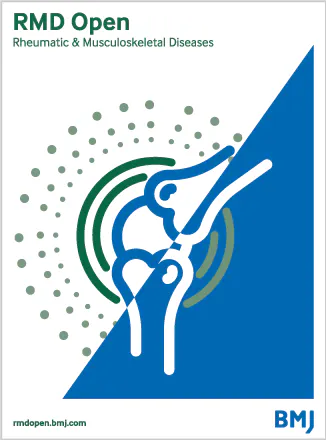Development and validation of a self-updating gout register from electronic health records data
IF 5.1
2区 医学
Q1 RHEUMATOLOGY
引用次数: 0
Abstract
Objective To develop an automatic gout register from electronic health records (EHRs) data. Methods We analysed the EHR of all patients >18 years old from a tertiary academic hospital (2013–2022) based on six criteria: International Classification of Diseases 10 gout diagnosis, urate-lowering therapy prescription, monosodium urate crystals in joint aspiration and gout-related terms in problem lists, clinical or imaging reports. We assessed the positive and negative predictive value (PPV and NPV) of the query by chart reviews. Results Of 2 110 902 outpatients and inpatients, 10 289 had at least one criterion for gout. The combination of joint aspiration OR diagnostic in the problem list OR≥2 other criteria created a register of 5138 patients, with a PPV of 92.4% (95% CI 88.5% to 95.0%) and an NPV of 94.3% (95% CI 91.9% to 96.0%). PPV and NPV were similar among outpatients and inpatients. Incidence was 2.9 per 1000 person-year and dropped by 30% from the COVID-19 pandemic onward. Patients with gout were on average 71.2 years old (SD 14.9), mainly male (76.5%), overweight (69.5%) and polymorbid (mean number of comorbidities of 3, IQR 1–5). More than half (57.4%) had received a urate-lowering treatment, 6.7% had a gout that led to a hospitalisation or ≥2 flares within a year and 32.9% received a rheumatology consultation. Conclusion An automatic EHR-based gout register is feasible, valid and could be used to evaluate and improve gout management. Interestingly, the register uncovered a marked underdiagnosis or under-reporting of gout since the COVID-19 pandemic.利用电子健康记录数据开发和验证痛风自我更新登记册
目的 从电子健康记录(EHR)数据中建立痛风自动登记册。方法 我们根据六项标准分析了一家三级学术医院所有 18 岁以上患者的电子病历(2013-2022 年):国际疾病分类 10》痛风诊断、降尿酸治疗处方、关节抽吸中的尿酸单钠结晶以及问题列表、临床或影像报告中与痛风相关的术语。我们通过病历审查评估了查询的阳性预测值和阴性预测值(PPV 和 NPV)。结果 在 2 110 902 名门诊和住院患者中,10 289 人至少有一项痛风标准。结合关节抽吸或问题列表中的诊断或≥2个其他标准,建立了5138名患者的登记册,其PPV为92.4%(95% CI为88.5%至95.0%),NPV为94.3%(95% CI为91.9%至96.0%)。门诊病人和住院病人的 PPV 和 NPV 相似。发病率为每千人年2.9例,从COVID-19大流行开始下降了30%。痛风患者平均年龄为 71.2 岁(SD 14.9),主要为男性(76.5%)、超重(69.5%)和多病(平均合并症数为 3,IQR 1-5)。半数以上(57.4%)的患者接受过降尿酸治疗,6.7%的患者因痛风住院或一年内复发≥2次,32.9%的患者接受过风湿病咨询。结论 基于电子病历的痛风自动登记册可行、有效,可用于评估和改善痛风管理。有趣的是,登记册发现,自COVID-19大流行以来,痛风的诊断或报告明显不足。
本文章由计算机程序翻译,如有差异,请以英文原文为准。
求助全文
约1分钟内获得全文
求助全文
来源期刊

RMD Open
RHEUMATOLOGY-
CiteScore
7.30
自引率
6.50%
发文量
205
审稿时长
14 weeks
期刊介绍:
RMD Open publishes high quality peer-reviewed original research covering the full spectrum of musculoskeletal disorders, rheumatism and connective tissue diseases, including osteoporosis, spine and rehabilitation. Clinical and epidemiological research, basic and translational medicine, interesting clinical cases, and smaller studies that add to the literature are all considered.
文献相关原料
| 公司名称 | 产品信息 | 采购帮参考价格 |
|---|
 求助内容:
求助内容: 应助结果提醒方式:
应助结果提醒方式:


